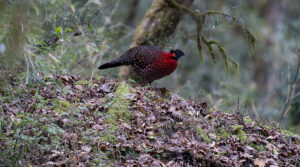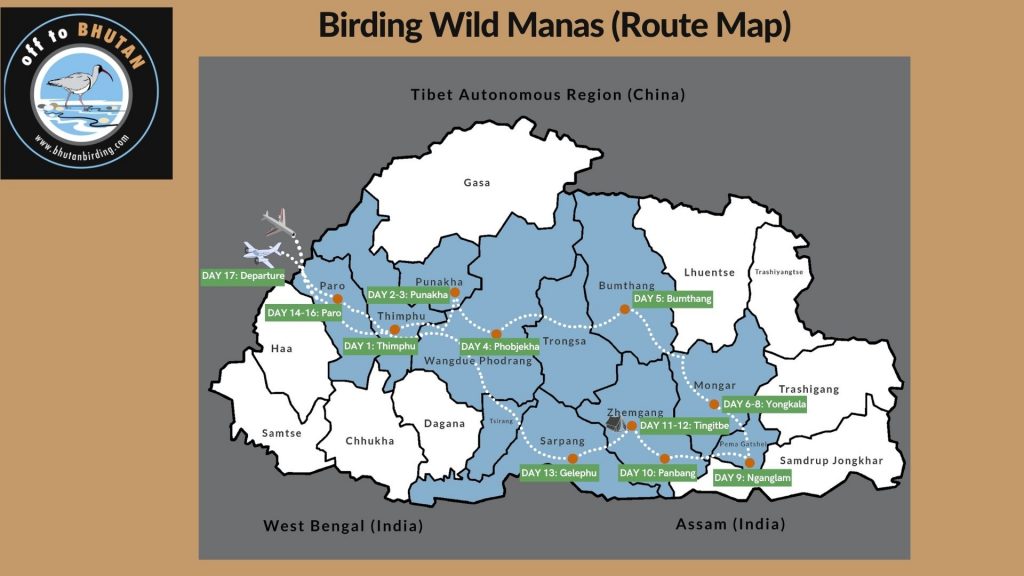
Bhutan Birding’s Jewel




This tour is an extensive lean-season winter birding tour led by Norbu, the founder of the company. Norbu is one of the most senior and top birding guides in Bhutan with experience of over 20 years. He has guided some of the most known international birders.
The tour takes you to some of the most remote and least explored sections of the country including the Manas National Park. The Royal Manas is not only the most diverse protected area in the Kingdom but also one of the world’s biologically outstanding conservation sites. It is the oldest protected area in the country.
Some of the desirable species you might see on this trip included three species of Pheasants and Hornbills, Ward’s Trogon, Ibisbill, Black-necked Cranes, Yellow-rumped Honeyguide and Beautiful Nuthatch, one of the most sought-after specialties of the Bhutan avifauna. All in all, we have a good chance of sighting over 300 species of birds and 10 – 15 species of mammals such as three species of langurs, including the nearly endemic Golden Langur, which is fairly common in Manas, Himalayan Giant Squirrel, Yellow-throated Marten, and Himalayan Goral.
Other highlights include a visit to Bhutan’s most scenic icon and a most important destination for pilgrimages Taktsang Monastery (Tiger’s Nest), the most beautiful and impressive Punakha Dzong, and a visit a typical Bhutanese farmhouse to experience the local hospitality.
Day 1 | Arrive at Gelephu, after short downtime and refreshment. we will do some introductoryBhutan birding around the town and Gelephu sewage pond. Overnight: Gelephu |
Day 2 | Gelephu – Tamala – Tingitbe: Off to Tingtibe with several birding stops along the way. Exploring wide ranges of habitats from the altitude of 150m to 2500m. (Overnight: Tingtibe) |
Day3 | Tingtibe – Dakphel and Gomphu Road: we will spend our entire morning birding the entire stretch of Zhemgang – Dakphel and Gomphu road, habitat mostly consists of cool, warm broadleaved, sub-tropical forest and continuous bamboo. Overnight Tingitbe |
Day 4 | Tingitbe –Gomphu – Panbang: Today we’ll leave Tingtibe and head toward the south to theRoyal Manas (250m) is another beautiful and scenic ride. We will have several stops along the drive be exploring the low lands and the tropical forest mixed with evergreen trees and bamboo. Overnight: Panbang |
Day 5 | Panbang –Nganglam: our trip to Nanglam (570m) is the least visited district by tourists not because it’s restricted but because of its remoteness and the non existence of a direct or pass-through highway until recently. Our trip today would take us through the mixed bamboo forest that hosts many cool species. Overnight: Nganglam |
Day 6 | Nganglam – Gyalpoizhing – Yongkala: After our final morning birding in this wonderful and least explored habitat, we’ll wind up on way to Yongkala, our journey takes us through the newly built double lane Nganglam – Gyalpoizhing crossing many bridges through the rugged terrain. Later in the evening, we will spend birding above the town of Limithang, habitats consisting of scrub and subtropical forest and farmland. Overnight:Yongkala |
Day 7 – 8 | Yongkala – Namling – Limithang Road these two days, we will explore the entire stretch of Namling, Limithang road, and all the way to Phrumshingla pass. This stretch of77-kilometer road all inside Phrumshingla National Park is touted as one of the finest birding sites in Asia. Overnight: Yongkala |
Day 9 | Yongkala– Bumthang after very early breakfast, we’ll be moving uphill in search of high-altitude species, we cross one of the high passes, the Phrumshing La, at3800m. Phrumshing La is the prime habitat for Blood Pheasant and also holds other high-altitude species. Overnight: Bumthang |
Day 10 | Bumthang– Phobjekha: basically, more like transit day driving most of the time. By evening we’ll enter Phobjekha valley, the wintering home for endangeredBlack-necked Cranes. Overnight: Phobjekha |
Day 11 | Phobjekha – Punakha: morning birding along the old abandoned road at Pelela pass in an open meadow and Rhododendron Forest. Afternoon birding Punatshang Chu river, the wintering paradise for migratory birds, and thePho Chu river (male river) to search for the White-bellied Heron, one of the rarest birds in the world. Overnight: Punakha |
Day 12 | Punakha – Thimphu visits the impressive Punakha’s Punthang Dechen Phodrang (Palace of Great Bliss) standing on the confluence of the two rivers, the Phochu and Mochu. Drive to Thimphu through mixed evergreen and broad-leaved forests to the pass at 3140 meters stopping en route at Lamperi Botanical Park and taking a nature walk. Evening we will bird Babesa Sewage Pond south of Thimphu town. Overnight: Thimphu |
Day 13 | Thimphu– Chelela pass Very early in the morning take 3hrs. drive to the cool alpine meadow of Chelela pass (3,890m). this is the highest pass on the car road and the highest point of our trip. Here we should be rewarded with the three different species of Pheasants, Colorful Himalayan Monals, flocks of Blood Pheasants, and Kalij Pheasants. Afternoon free time to wander around downtown Paro: Overnight:Paro |
Day 14 | Paro – Tiger’s Nest excursion Excursion to Tiger’s Nest Monastery: Hike to the Tiger’s Nest monastery, one of the most beautiful and holiest temples in Bhutan. Overnight: Paro |
Day 15 | Departure After breakfast at the hotel our representative, your tour guide, and driver will drive you to the airport and bid you goodbye. |
This birding tour will be on selected sites that do not pose any threats such as steep slopes. During these trips, you should expect yourself to walk at least 6-7 kilometers on average per day
The best time for watching birds is in the morning. You can expect an early start in the morning most of the time. However, a couple of very early mornings are required to look for high elevation dwelling Pheasant that comes out to the roadside early in the morning.
Accommodation on this tour is generally simple but comfortable. The hotels are generally spacious, clean, and comfortable, built-in westernized Bhutanese style, and all rooms have private facilities. However, due to the limited availability of good lodges and hotels in some remote parts of the country, you will spend a couple of nights in basic hotels or tented camps.
Generally, the weather should be mostly fine and sunny during the daytime with temperatures varying from 5-25°C but it can get quite cold and chilly at night and during early morning at some higher altitude places with the temperature expected to go below zero and warm and pleasant weather in the lowland.
What is Included?
- • All internal taxes and charges (including SDF)
- • Accommodation on twin sharing basis
- • All meals, tea, snack and bottled water
- • All travel with a licensed local birding guide
- • All surface transfers by a private vehicle
- • Camping equipment and haulage for camping and trekking tours
- • All entry fees to monuments, Museum and National Parks
- • Bhutan Visa Fee
What is not Included?
- • Optional tours/excursions, personal & incidental expenses.
- • Tips, laundry, phone calls, and bars.
- • International and domestic air fare, and insurance

Norbu is the founder of Off to Bhutan Travel and Lead guide. He is probably one of the first local birding guides who has led the international birding clients independently. With over 20 years of experience exploring the country’s varied ecosystems, he has contributed to the knowledge of the status and distribution of many species that were previously poorly known including three new species added to the country’s list.
He also does extensive recording in Bhutan and has a very large library of local songs. Many of these songs and calls he has generously donated both to Cornell University’s Macaulay Library and to the public site, xeno-canto. He is also a passionate wildlife photographer; you can see some of his photographs used in the new and updated field guide to the “Birds of Bhutan and the Eastern Himalayas”.
HHHHHH
5HHHHHHB



